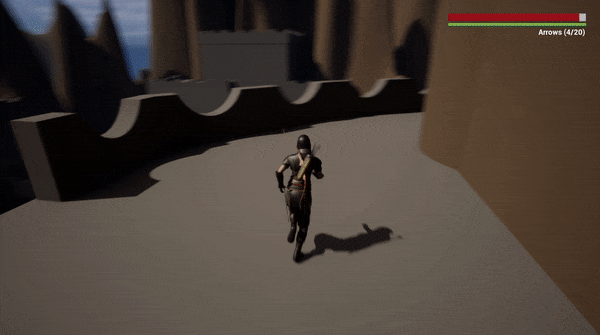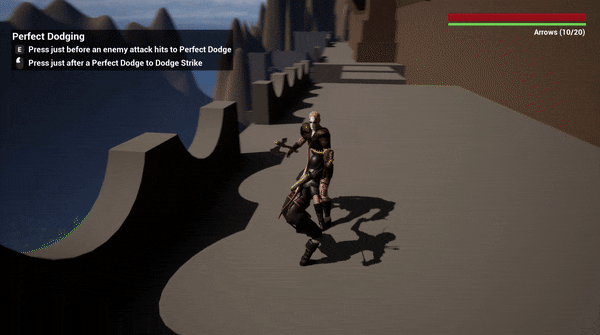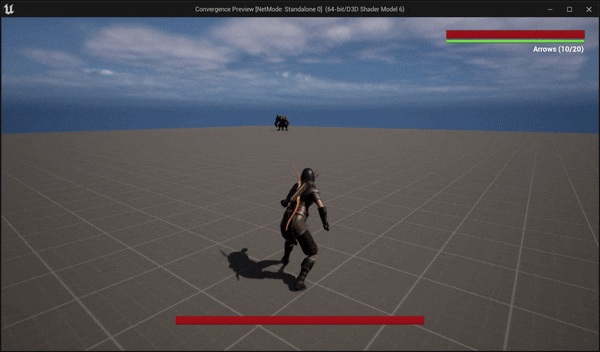CONVERGENCE
OVERVIEW
Description:
Convergence began as an exploration of Unreal Engine 5 and quickly expanded into an ambitious project to create a demo level one might find in narrative-driven action-adventure series such as Uncharted, The Last of Us, or The Legend of Zelda. The level follows a warrior named Rae as she makes her way toward a cultist-occupied keep in search of missing villagers.
Solo Developer
Role:
Platform:
PC
Year:
2023
RESPONSIBILITIES
Devised, wrote, and implemented all narrative content
Scripted flexible dialogue system to support both scripted and systemic vox lines and subtitles
Crafted four cutscenes, incorporating vox lines, subtitles, animations, audio, and cinematic camera work
Narrative Design:
Authored combat system encompassing both melee and ranged weapon types in addition to dodging, blocking, parrying, target locking, and finishers
Designed and scripted abilities and AI for three main enemy types, including a melee fighter, ranged archer, and boss
Designed and scripted traversal and stealth mechanics, including a climbing system, general movement, stealth takedowns, and x-ray listen mode
Designed and constructed an original level, prioritizing narrative delivery, combat spaces, and tutorialization of key mechanics
Scripted UI ranging from menus to tutorial slide-ons
Game Design:
Implemented all characters, audio, animations, foliage, and particle effects
General:
NARRATIVE
Dialogue System:
In scripting the dialogue system for this project, the goal was to make something flexible and robust that supported both written and spoken dialogue and integrated well with Unreal 5’s built-in cinematics tools. It also needed to work with scripted/authored dialogue and systemic barks. What I eventually arrived at was a system heavily inspired by Naughty Dog’s (as discussed in this excellent GDC talk) which uses rules (or in my case a priority denoted by an integer) to determine if and when a line should play. This ended up being extremely effective, as it allowed me to set up dialogue across cinematics, traversal, and combat, while mitigating overlap or incorrect timing.
Cinematics:
A key goal when starting this project was to improve my narrative presentation, and for me, that meant incorporating real-time cinematics and VO lines. Unreal comes with a great suite of cinematics tools, which I used to set up four cinematics throughout the game’s level. With each, I paid careful attention to animations, audio, and camera positioning, and scripted various events to promote as seamless an integration with gameplay as possible.
COMBAT
Player:
When designing the player character, I took inspiration from many modern action games/series, including The Legend of Zelda and Ghost of Tsushima. My goal was to use combat mechanics to promote the narrative fantasy of a nimble warrior intent of driving a malevolent force from her home. This meant ensuring the player not only had a variety of actions at their disposal, but that they also felt quick and responsive. What I eventually landed at were two main weapon types, Blade and Bow, each allowing for unique styles of engagement. For melee, the player has both a light and heavy attack combo, with the latter costing stamina. Additional actions include:
Dodging, which can be timed and paired with a standard melee attack to perform a dodge strike
Blocking, which can be timed to perform a parry
Lock on targetting, which allows the player to focus on one enemy at once
Finishing moves, which allow the player to briefly become invincible as they defeat low-health enemies with a flourish
Enemies:
In designing the game’s three enemy types, my two focuses were their various unique actions as well as the different states present in their AI.
Melee Fighter and Archer
For the melee fighter and archer, the goal was to have their abilities mirror and counter the player’s own. The melee fighter’s constant pursuit and archer’s deadly accuracy encourage the player to stay mobile, pick their targets, and rely on tactics other than constantly attacking, especially when facing multiple combatants at once. Both these enemies use an AI behavior tree consisting of four states: Patrolling, Investigating, Chasing/Combat, and Searching, which the player can approach as they see fit, choosing to attack head-on or opting to stealthily take out enemies one by one.
Boss
For the final boss, the goal was to keep players on their toes and prompt them to think creatively as they memorized the boss’ different attacks and their animation/audio cues. Unlike the standard enemies, the boss has one AI state: Chasing, so the player is forced to face him directly rather than escape and catch him by surprise. The boss has a basic attack combo much like the melee fighter, though, unlike the melee fighter, his attacks cannot be interrupted. In addition, he has three special, high-damage attacks at his disposal, including a charge attack, a jump and slam attack, and a rock throw attack. Each of these attacks is effective at both short and long distances, being meant to counter both the player’s Blade and Bow simultaneously.
TRAVERSAL & STEALTH
Traversal:
The game’s main traversal mechanic is climbing, which is heavily inspired by the climbing system in Breath of the Wild and its sequel, Tears of the Kingdom. While initially planning to do an edge-based system like those found in the likes of Uncharted or Horizon Zero Dawn, I eventually opted for a system like Zelda’s to have the added flexibility (Plus, I was really curious about how such a system worked). What I ended up with is very in line with its inspiration, allowing the player to climb any surface up to a certain angle at the cost of stamina. If the player’s stamina runs out, they lose their grip and fall, forcing them to monitor their stamina gauge. Additionally, if the player takes damage while climbing, they will momentarily lose their grip, encouraging them to time their climbing between ranged enemy attacks.
Stealth:
The game’s stealth mechanics were largely inspired by The Last of Us and Ghost of Tsushima. While attacking enemies directly is entirely viable, I wanted to give players the option approach combat encounters quietly and with more finesse, emphasizing the assassin-esque fantasy present in many beloved action-adventure and stealth games. On the enemy side, this meant creating the four afforementioned AI states, which the player can navigate between. Of course, any stealth experience is only as great as the stakes involved. Thus, enemies have four main senses: Sight, Hearing, Touch, and Damage, each of which can pick up on the player and trigger combat if they aren’t careful. At the player’s disposal is the ability to crouch and silence their footsteps, the ability to silently takedown enemies so long as they aren’t in combat, and an Enhanced Listen Mode, which allows them to see nearby enemies through walls.
Tools:
Unreal Engine 5














